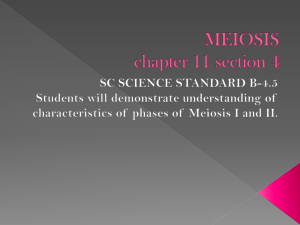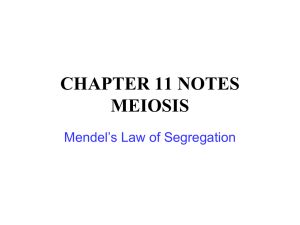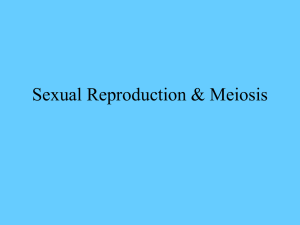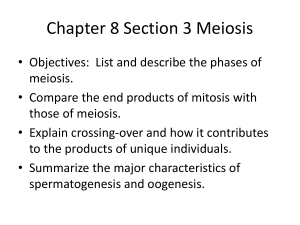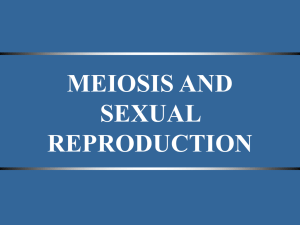Meiosis - An
advertisement
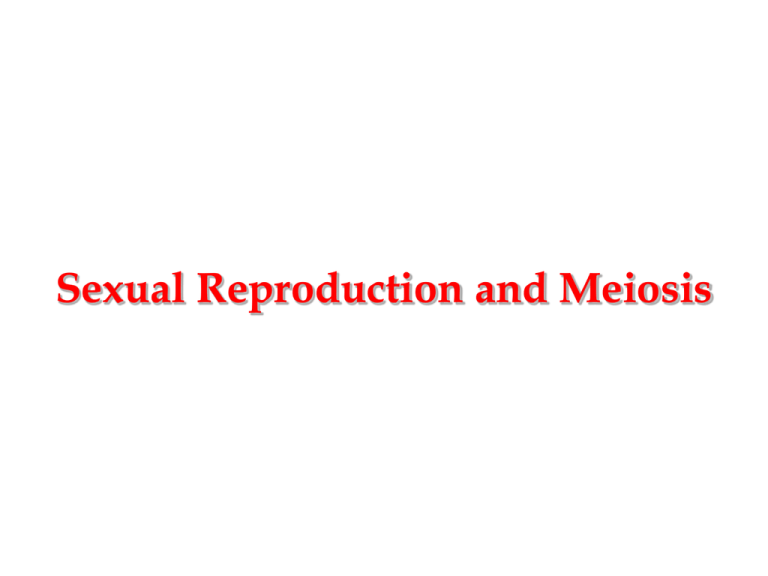
Sexual Reproduction and Meiosis Meiosis produces haploid cells from diploid cells Discovery of Reduction Division Belgian cytologist Pierre-Joseph van Beneden was surprised to find different numbers of chromosomes in different types of cells in the roundworm Ascaris. Specifically, he observed that the gametes (eggs and sperm) each contained two chromosomes, while the somatic (nonreproductive) cells of embryos and mature individuals each contained four. The Sexual Life Cycle Meiosis and fertilization together constitute a cycle of reproduction. Two sets of chromosomes are present in the somatic cells of adult individuals, making them diploid cells (Greek diploos, “double” + eidos, “form”), But only one set is present in the gametes, which are thus haploid (Greek haploos, “single” + ploion, “vessel”). Reproduction that involves this alternation of meiosis and fertilization is called sexual reproduction. Its outstanding characteristic is that offspring inherit chromosomes from two parents Meiosis has three unique features. The mechanism of cell division varies in important details in different organisms. This is particularly true of chromosomal separation mechanisms, Meiosis in a diploid organism consists of two rounds of division. Although meiosis and mitosis have much in common, meiosis has three unique features: 1. Synapsis. 2. Homologous recombination. 3. Reduction division. 1. Synapsis The first unique feature of meiosis happens early during the first nuclear division. Following chromosome replication, homologous chromosomes, or homologues pair all along their length. The process of forming these complexes of homologous chromosomes is called synapsis 2. Homologous Recombination The second unique feature of meiosis is that genetic exchange occurs between the homologous chromosomes while they are thus physically joined )crossing over). Chromosomes are then drawn together along the equatorial plane of the dividing cell; subsequently, homologues are pulled by microtubules toward opposite poles of the cell. When this process is complete, the cluster of chromosomes at each pole contains one of the two homologues of each chromosome. Each pole is haploid, containing half the chromosomes present in the original diploid cell. number of Sister chromatids do not separate from each other in the first nuclear division, so each homologue is still composed of two chromatids. Crossing-Over 3. Reduction Division The third unique feature of meiosis is that the chromosomes do not replicate between the two nuclear divisions, so that at the end of meiosis, each cell contains only half the original complement of chromosomes. In most respects, the second meiotic division is identical to a normal mitotic division. However, because of the crossing over that occurred during the first division, the sister chromatids in meiosis II are not identical to each other. Meiosis is a continuous process, but it is most easily studied when we divide it into arbitrary stages. In meiosis, however, prophase I is more complex than in mitosis. Prophase I In prophase I, homologous chromosomes become closely associated in synapsis, exchange segments by crossing over, and then separate. Prophase I is traditionally divided into five sequential stages: 1. Leptotene: Chromosomes condense tightly. 2. Zygotene: A lattice of protein is laid down between the homologous chromosomes in the process of synapsis, forming a structure called a synaptonemal complex. 3. Pachytene: Pachytene begins when synapsis is complete (just after the synaptonemal complex forms and lasts for days. This complex holds the two replicated chromosomes in precise register, keeping each gene directly across from its partner on the homologous chromosome, like the teeth of a zipper. Within the synaptonemal complex, the DNA duplexes unwind at certain sites, and single strands of DNA form base-pairs with complementary strands on the other homologue. The synaptonemal complex thus provides the structural framework that enables crossing over between the homologous chromosomes. 4. Diplotene: • At the beginning of diplotene, the protein lattice of the synaptonemal complex disassembles. • Diplotene is a period of intense cell growth. • During this period the chromosomes decondense and become very active in transcription. 5. Diakinesis: • At the beginning of diakinesis, the transition into metaphase, transcription ceases and the chromosomes recondense. Metaphase I By metaphase I, the second stage of meiosis I, the nuclear envelope has dispersed and the microtubules form a spindle, just as in mitosis. Terminal chiasmata hold the homologous chromosomes together in metaphase I, so that only one side of each centromere faces outward from the complex. Consequently, spindle microtubules are able to attach to kinetochore proteins only on the outside of each centromere, and the centromeres of the two homologues attach to microtubules originating from opposite poles. The orientation of each pair on the spindle axis is random: either the maternal or the paternal homologue may orient toward a given pole. Anaphase I As the microtubules shorten, they break the chiasmata and pull the centromeres toward the poles, dragging the chromosomes along with them. When the spindle fibers have fully contracted, each pole has a complete haploid set of chromosomes consisting of one member of each homologous pair. Because of the random orientation of homologous chromosomes on the metaphase plate, a pole may receive either the maternal or the paternal homologue from each chromosome pair. As a result, the genes on different chromosomes assort independently; that is, meiosis I results in the independent assortment of maternal and paternal chromosomes into the gametes. Telophase I By the beginning of telophase I, the chromosomes have segregated into two clusters, one at each pole of the cell. Now the nuclear membrane re-forms around each daughter nucleus. Because each chromosome within a daughter nucleus replicated before meiosis I began, each now contains two sister chromatids attached by a common centromere. Importantly, the sister chromatids are no longer identical, because of the crossing over that occurred in prophase I. Cytokinesis may or may not occur after telophase I. The Second Meiotic Division After a typically brief interphase, in which no DNA synthesis occurs, the second meiotic division begins. 1. Prophase II. At the two poles of the cell the clusters of chromosomes enter a brief prophase II, each nuclear envelope breaking down as a new spindle forms. 2. Metaphase II. In metaphase II, spindle fibers bind to both sides of the centromeres. 3. Anaphase II. The spindle fibers contract, splitting the centromeres and moving the sister chromatids to opposite poles. 4. Telophase II. Finally, the nuclear envelope re-forms around the four sets of daughter chromosomes. The final result of this division is four cells containing haploid sets of chromosomes. No two are alike, because of the crossing over in prophase I. Nuclear envelopes then form around each haploid set of chromosomes. The cells that contain these haploid nuclei may develop directly into gametes, as they do in animals. Alternatively, they may themselves divide mitotically, as they do in plants, fungi, eventually producing greater numbers of gametes. The End
